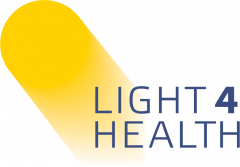L4H Health Research for Lighting Design Online Course
Description: The online course includes five educational modules (see below for more details). It presents different available tools, concepts, and research findings to inform lighting design. This is achieved in two distinct ways: (1) by exposing students to knowledge and examples of lighting-related health research in different fields of psychology and physiology; and (2) by guiding students to learn how to conduct their own evaluation and data collection: what can be measured, and how measurements get interpreted
Access to course: The course is accessible from a Moodle learning management system using the following URL: https://course.light4health.net
First time Access Instructions : For first time login, a user account needs to be created at: https://course.light4health.net. It is the same process for all the users of the platform (e.g. students, teachers, professionals). More details for the L4H online course enrolment can be found here.
Disclaimer: The consortium partners acknowledge that the content, while extensive, does not encompass the full extent of the work done in health-related lighting design research. The current course content is subject to refinements, updates and additions in later phases. Comments and suggestions are welcome and should be addressed to info [at] light4health.net
Terms of Use: All course content is available for open-access use either in part or in its entirety, with proper crediting: Copyright © Light4Health 2021. For educational use only. Not for Commercial Use. Available to third parties under Creative Commons (Attribution, Non-Commercial, No Derivatives) 4.0 Public License. For any inquiries please contact info [at] light4health.net
Course Modules:
Module 1: Introduction to health-related research for lighting design
Module 1 provides an introduction, discussing why we need to consider health as part of lighting design, as well as a short history of light and health. It also discusses the effects of light on the human body by introducing aspects of the physics of light and the physiology of vision
Module 2: Review on lighting basics and health and wellbeing research topics
Module 2 provides a review of lighting basics and lighting-related aspects of health. It discusses daylight in architecture, daylight’s impact on health, and, in general, the neuroendocrine, neurobehavioral, and circadian effects of light on the human body. In this module the psychology of light is also introduced; more specifically, how light is used as a visual trigger for psychological and behavioral impact. In addition, the topics glare and flicker are discussed.
Module 3: Software, measuring devices and evaluation tools
Module 3 is about software, measuring devices, and evaluation tools. Metrics are presented which can be used to assess the potential for the physiological impact of lighting, and different software and measurement tools are discussed. In addition, some assessment techniques for subjective impressions of a space are presented. Finally, a tour of the Jefferson Lighting Research Lab is given.
Module 4: Standards and best practices
Module 4 provides an overview of standards and good practices. Metrics for daylight evaluations are presented, and the “Manchester Recommendations” for healthy daytime, evening, and nighttime indoor light exposure are introduced. Moreover, design integrations are discussed employing measurements and design criteria for physiological impact and visual perception.
Module 5: Application and examples from research and practice
Module 5 provides application examples and case studies from research and practice. In this context, several examples of light and health research are presented. Among others, project examples from workspaces, educational and healthcare environments, considerations for specialty applications (e.g., space travel, users with autism), and concepts of spectral modelling for light and health considerations, double dynamic lighting, biophilia and information on therapeutic lighting applications are also included.
